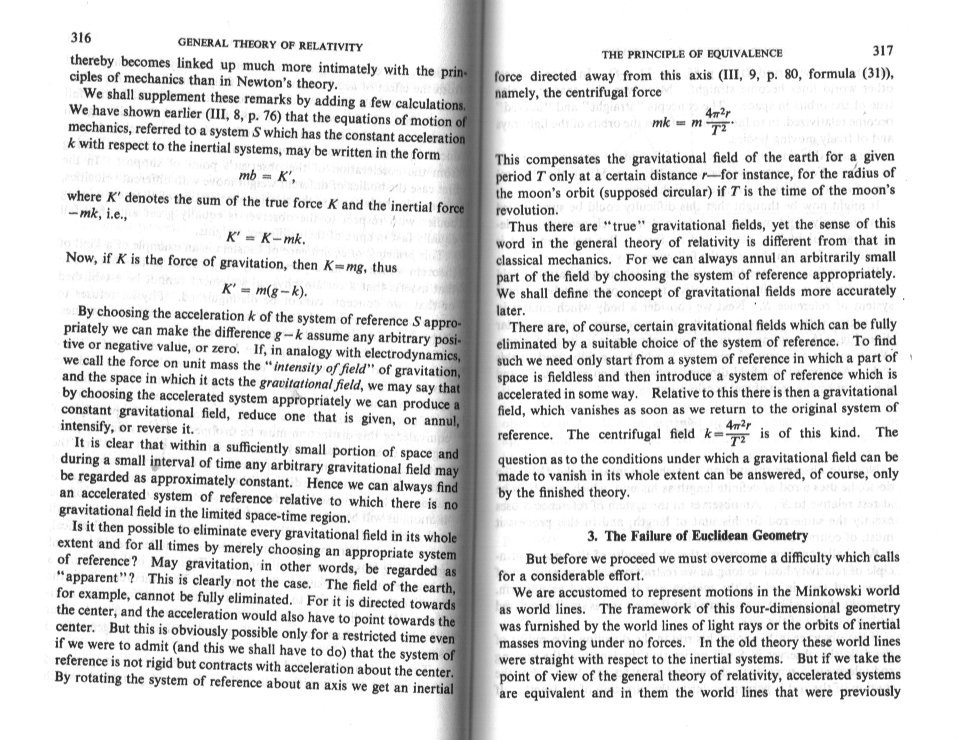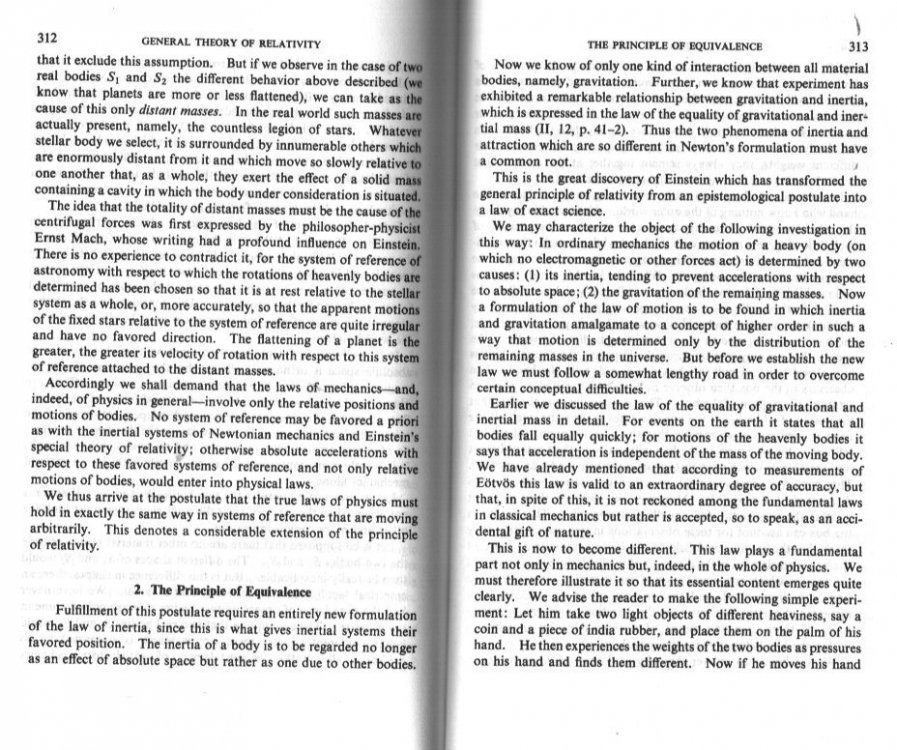-
Posts
18316 -
Joined
-
Last visited
-
Days Won
104
Content Type
Profiles
Forums
Events
Everything posted by studiot
-
You heat me to it, and you expressed it better. +1
-
Once again a masterful summary. +1 I can only add my comment that trying to deduce facts about 'free will' from the separable actions of single (elementary) particles and transferring these observations from systems of the order of 100 particles to systems of the order of 1025 particles is about as sensible as arguing over Schrodinger's Cat's Tale (Which tail(pun intended) is based on the same macro v micro difficulty)/
-

The use and value of Philosophy to Science.
studiot replied to studiot's topic in General Philosophy
Thank you for your well reasoned reply. +1 Have you heard of counterfactuals ? -
I can't tell if this is a single quote or a pastiche of quotes or if it is your own work with references. (if it is your own, although misguided its good work). A bald statement that something does or does not obey the Second Law is not sufficient. We need a chain of reasoning, starting from agreed known facts, leading to the claim as a final conclusion, all stated here. I asked you to define your version of complexity. Instead of an answer you have introduced more new words such as order and disorder without definition. Please discuss this properly. According to what I know about Plato, he was about simplificaction not complexification. He believed in so called perfect or ideal systems, the simpler the better.
-
I don't see anything funny in this. I am glad you decided to take things more (scientifically) seriously though. So your speculation is that increase of 'complexity' (depending upon how you define the term) is a driver of processes in a similar way to those of minumum energy or maximum entropy ? How does this work with the Second Law maximum entropic 'hot death' of the universe ? Maximum entropy is often aligned with minimum complexity.
-

Has household electrical energy consumption increased or decreased ?
studiot replied to Externet's topic in Engineering
+1 for putting lots of good things into this thread. -
I'd like to start my response by stating that the first time and only I have heard of Jordan Peterson, let alone his ideas, was in this thread. I can't say that what I have learned has led me to want to know more. I note that no one has introduced the issue of 'nature v nurture' here in this thread. I consider this aspect of vital importance to the question. I understand Jordan is a professor of Psychology, which makes his stance all the more surprising to me, as it only addresses nature. Human beings are amazingly adaptable creatures, in no small part as a result of their powerful ability to learn. In other words humans can be programmed and reprogrammed - this is the nurture part. Obviously they can only be programmed to think and act according to their capabilities and capacities. But we know that some ordinary citizens (ie those who would not ordinarily even dream of doing such things) can be programmed (taught) to sneak up behind someone and strangle them with a garotte wire.
-
Not quite. Yes binary is a base 2 number representation system. But no, it does not use 2 states on their own to represent a number. That could only ever represent 2 numbers. A number system are designed to represent all the numbers in its particular range. In order to do this you can either use a different symbol for every number, which is obviously inefficient and difficult to learn. Or you can repeat symbols in some way, with each repetition having a different meaning. The smallest count of symbols you need to do this is called is 2 and is called binary. 2 is then called the base. One consequence of using 2 is that it leads to very long representations of numbers, both numerically bigger numbers and fractions. In general, The larger the count of symbols the shorter the repreentation becomes. So if use use 3 symbols we get ternary numbers, also called trinary numbers So if use use 4 symbols we get quaternary numbers So if use use 5 symbols we get quinary numbers So if use use 6 symbols we get seximal numbers So if use use 7 symbols we get septernary numbers So if use use 8 symbols we get octal numbers - note this one does not follow the pattern and is abused by computer science to also mean groupings of binary numbers. So if use use 9 symbols we get nonnary numbers So if use use 10 symbols we get denary numbers commonly, but wrongly, called 'decimal numbers'. So if use use 16 symbols we get hexadecimal numbers or hex numbers. Mixed representations can also be used, such as BCD or binary coded decimal and octal. Up to and including base 10 we use the 10 digits 1 through 9 and zero as the symbols To additional obtain symbols for number systems with a base greater than 10, we use letters from the Latin alphabet, eg hex numbers use the 6 letters A,B,C,D,E and F. Does this help ?
-
So this is homework/classwork. So it should be posted in homework help and you should tell us what you do know about the subject and at what point you came across something you don't understand. That is what have you done so far ?
-
Where is this from ? Surely it is a trick question, I have never seen so many distractors in a question before.
-
You do not need a measure in standard set theory to define a point, any more than you need a coordinate system or a dimension theory. A point, eg in the Reals, is a subset (partition) with exactly one entry. But yes using using the apparatus of epsilon delta, or of measure theory leads to your definition or Markus' limit. Conscious Energy has left the room, courtesy Swansont. But it was never clear whether they were referring to a mathematical or physical point.
-
Is this a schoold project ? Very nice if so. I'd love to see how probability distributions are used to distinguish between a snadbag and a maracas ? OK if we are talking about sounds that can be made using granular materials, I would start but observing the difference between sounds generated by 'soft' materials such as flour, soft breadcrumbs, foam rubber chunks etc and 'Hard' materials such as macaroni, dry sand gains, hard plastic beads, steel shot, etc. A simple sound test can be made by pouring a stream of these onto a) a hard surface such as a formica table top, a sheet of steel, glass or marble etc. b) a soft surface such as a rubber sheet, a cloth over the hard surfaces, etc. For each test you may be able to distinguish two types of sound. a) The sound of the stream of granules impacting upon the test surface. b) The sound the stream makes as the particles bump together as you pour. For a maracas you need (a) in both cases. The sound is made by stopping and starting the 'stream', as it bumps agains first one side then the other of the container, followed by a trailing sound of the hard particles bunmping together because the maracas is not full. For a sandbag you need a soft cloth surface (bag) more nearly fully filled and you strike the bag, which you do not do with the maracas (which you shake). The principle sound will be the softer sound of a few of the grains rubbing rather than bumping together as the bag and contents distort in shape. There will be no impact sounds against the soft cloth walls. Sand grains are hard in both cases. In the case of flour it is the flour grains themselves whicha re soft and so capable of significant distortion when bumped against each other. It is this distortion that absorbs the energy which would be given out as sound if the grains were hard. I wish you well with your investigation, It is a fine project.
-
In Autumn, (note spelling) actually they don't 'turn' yellow, red etc. What actually happens is that the plant stops producing chlorophyl, which give plants their green colour and masks the colouring of any other chemicals. As the chlorophyl dissipates the green fades away leaving tthe base colour. Then the residual chemicals start to form darker sugars which make the leaves darken from yellow through orange, red and brown.
-
Read this (1962 edition) from Einsteins's friend ,nobel Physicist, Max Born. Sorry it's all words. No Pictures.
-

Has household electrical energy consumption increased or decreased ?
studiot replied to Externet's topic in Engineering
From the 1990s to 2016 My annual usage was 2500 to 4000 units (kw-hrs). Heating and hot water was additional by gas. In 2016 I installed a heat pump and did away with the gas. Since then usage has not quite doubled, although being home more with Covid restrictions, it was higher in the last two years. Since the national intention is to phase out gas boilers, I expect this trend to widen. -
First let me say what a well presented question you have asked. Keep this standard up and you will go far. +1 Now the books. First the Physics. The original editions of this book were written by Professors Sears and Zemansky in 1949. So you see that it has a very long history and pedigree and is very well respected. Young and later Freedman joined the team and the task of keeping it up to date. The material is aimed at high school and on into first year university level and offers a geat deal of excellent explanation and promotes understanding rather than clever mathematics. Yes understanding classical calculus is necessary to get the most out of this book, but not to the level of speciality you will find in Thomas. Having said that, Thomas is also a very good book (see below). But remember that students generally learn both the physics and Mathematics in tandem. So you will lear some Physics then some Mathematics, which will enable you to learn some more Physics ... and so on. Now the Mathematics. I have already praised Thomas. It contains a thorough introduction to 'the calculus' for students but to a depth and facility greater than is required for Physics as it really is a Mathematics book. So you will only need to learn it all if you are going to do further Mathematics. It will, however, provide the understanding you need to follow the Physics in Young etc. It should also serve well as a reference to go back to as you But it is not a pure Mathematics book and would not be of much use (except as background) in a formal University course in Analysis (The posh part of maths that includes calculus). But then formal university Analysis books are not much use in Physics either. Better than that it provides an elementary introduction to some more advanced mathematical topics, used in more modern Physics. For instance it provides a useful introduction to topics such as differential forms which you might require when going from first degree Phyics into postgrad. So both excellent choices that will last you a long time to come.
-
Hydrogen, Acetylene and ethane are all gases at STP so 0.1M is an unusual way to measure concentration. Any information on this ?
-
I think I need a holiday. First class catch, I misread the reply. + 1 😳
-
OK so you need the coefficient of restitution. This pdf is an advanced treatment, but includes explanation of the basics. http://citeseerx.ist.psu.edu/viewdoc/download?doi=10.1.1.402.4689&rep=rep1&type=pdf Note the poly tube will be in compression not tension at impact.
-
Depends upon if you are considering an elastic or inelastic impact ?
-

exclude password, what kind of login security tokens we can have?
studiot replied to PeterBushMan's topic in Computer Science
Is this homework ? Patterns, fingerprints, retinal scans, captcha type Q & A ................ -

The use and value of Philosophy to Science.
studiot replied to studiot's topic in General Philosophy
Indeed theoretical physicists at Oxford University have a whole department studying "The Science of Can and Can't" under David Deutsch. Stangely no one else seems interested in my thread on that subject. -

The use and value of Philosophy to Science.
studiot replied to studiot's topic in General Philosophy
Thank you for the response. I look forward to hearing what others have to say.





